Google Merchant for Ecommerce:
Boost Your Online Store with Data
Do you have an online store and want to sell more? Well, Google Merchant is not just the place where winners sell; it’s the perfect tool to gain insights that position you as a market leader. If you’re not there, you’re letting your competition take your customers.
What is Google Shopping?
There are numerous tools that can help us launch our ecommerce business. Today, we’ll discuss one of these tools to understand how to make the most of it and grow our online store by advertising and obtaining essential data about our products.
Google Shopping is a tool created by Google to enable ecommerce businesses to promote their products within Google. With its visual format, Google Shopping allows users to compare products and prices, offering a seamless shopping experience.
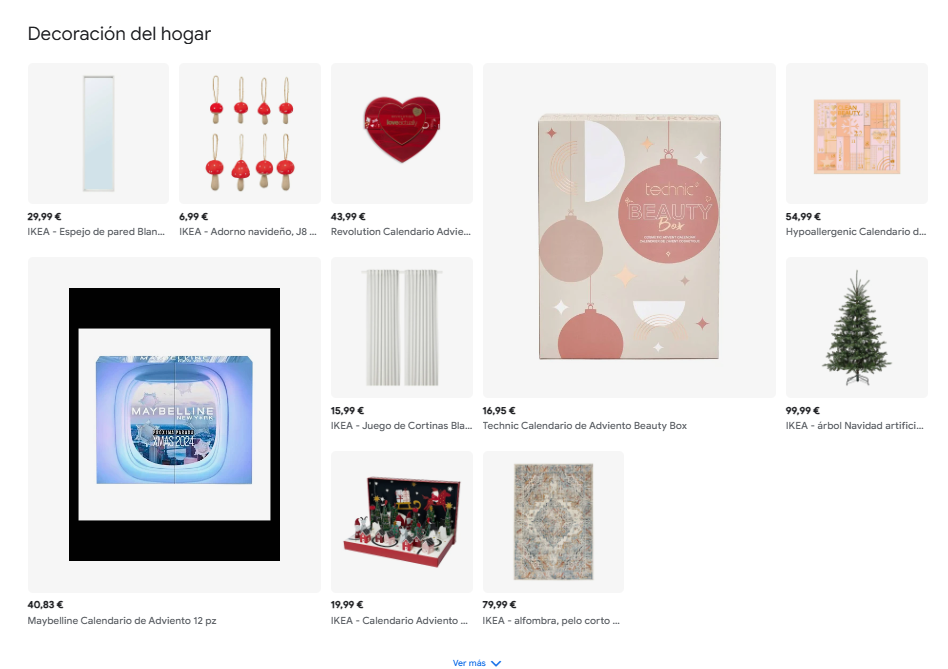
Google Shopping is not just a place to sell. It’s where your brand can stand out among thousands. Stop settling for scraps and learn how to use the tools that can make your products dominate the market.
How does Google Shopping work?
Using tools like Google Shopping is very simple for both the user and the ecommerce managing the product display and sales. Google Shopping allows ecommerce businesses to showcase their products on Google’s search engine and other affiliated sites through visual ads.

Unlike other tools like Google Ads, which works based on keywords, Google Shopping uses a product feed that mimics a store’s inventory. This feed allows the search engine to display products based on relevant search terms, directing shoppers to specific product pages and providing a direct, visually appealing shopping experience.
Additionally, Google Merchant Center gives you access to data that can help elevate the quality of your online store. Understanding and correctly utilizing this data is essential—something we’ll explain later, where KeyTrends will become your number one ally.
Google Shopping Features
The features of Google Shopping are like weapons in a battle. If you don’t use them well, you’re fighting without a sword. Here, we’ll show you how to make the most of them so your product ads don’t just exist—they dominate.
Google Shopping offers various features that help ecommerce businesses enhance their visibility, attract potential customers, and stand out among competitors. Below, we’ll break down the main features of this tool.
Product ad Display
The display of product ads on Google Shopping is different from other ad formats we’re used to seeing. These are highly visual ads that prominently showcase images of the product along with key details such as the price and name.
To make the most of these visually appealing ads, online stores must focus on the visual elements of their products. Using high-quality images from different angles that accurately represent the product is essential to building consumer trust.
Price Comparison
Google Shopping includes a feature that allows users to view and compare prices for similar products across different providers. This functionality is not only helpful for consumers seeking the best deals but also offers ecommerce businesses the opportunity to stand out in the market.
Leveraging this feature is essential for your online store to benefit from price competitiveness, positioning your products prominently in the price comparison tool with attractive pricing or special offers. Additionally, businesses can use price-tracking tools to monitor competitors, ensuring their products remain a standout option.
Ad Reach
Google Shopping provides extensive reach, as product ads don’t just appear in Google Search but also on other Google properties like the “Shopping” tab, YouTube, and various partner sites that display ads. This type of distribution allows stores to reach a broad and diverse audience, maximizing the exposure of their products.

Ecommerce businesses should take advantage of this reach and properly segment their campaigns to target specific audiences. To do this, it’s important to analyze which platforms generate the most traffic and adjust strategies to improve results on each channel.
For example, a clothing brand that also has physical stores can use Google Shopping ads to drive traffic not only to their online store but also to their physical locations by utilizing local inventory ads. This allows them to make the most of Google Shopping’s reach and direct users to the nearest stores.
Google Shopping Product Filters
Another feature of Google Shopping allows users to filter search results by various criteria, such as price, rating, brand, or store availability. These features make it easier for shoppers to find specific products that match their needs and preferences. This filtering capability enhances the user experience by allowing them to view only products that meet their expectations.
To take advantage of this functionality, ecommerce businesses must ensure their product feed is fully optimized and properly labeled so that their products appear in the correct filters. Proper categorization and tagging of products helps users easily find specific items in their store.
Product ratings and reviews
One of the key features in Google Shopping is the integration of product reviews and ratings. Star ratings and reviews help build trust and credibility by providing shoppers with firsthand information about the quality of the product and the satisfaction of other customers.

Showcase Shopping Ads
Showcase Shopping ads are another type of ad within Google Shopping that allows ecommerce businesses to display a selection of related products instead of just one. This format is ideal for products or categories with a wide range of options and is useful for capturing the attention of shoppers who are still exploring their choices.
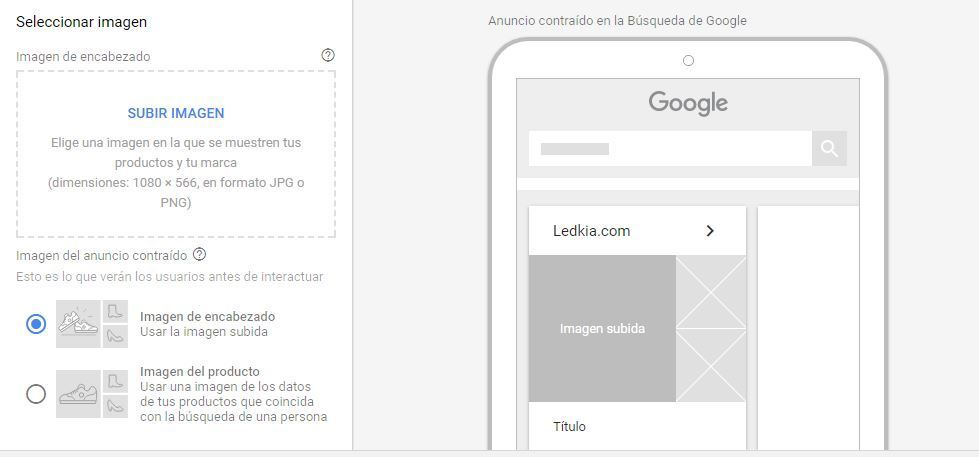
For example, a furniture store could use Showcase Shopping ads to display a selection of “living room sofas.” Shoppers would see various sofa styles available, which can inspire them to explore more options within the store’s catalog.
Benefits of Google Shopping
Tools like Google Shopping aim to maximize the visibility, reach, and sales performance of ecommerce businesses. However, to make the most of these advantages, it’s important to know how to act and how to drive your online store to success in the digital market.
Great Visibility
Google Shopping offers great visibility for products, especially thanks to its visual format and integration into Google Search and other Google platforms. Google Shopping ads are highly visual and often appear at the top of search results, helping to capture users’ attention quickly.
As mentioned earlier, just like gaining user trust, optimizing images is essential to turning users’ attention into clicks. Additionally, it’s important to leverage keywords in the titles to improve ad positioning.
Powerful conversion tool
Google Shopping has become a highly effective conversion tool because it attracts shoppers who already have a clear intent to buy. Users searching for products on this platform are typically in the final stage of the sales funnel, meaning they are ready to make a purchase. Additionally, the Google Shopping interface makes it easy to quickly compare products, which drives fast purchasing decisions.
To fully leverage this tool, ecommerce businesses must optimize product descriptions and prices to be competitive, ensuring that the feed content aligns with buyers’ expectations.
Furthermore, using promotional or discount labels can help incentivize conversions, as users are more likely to click on a product with an attractive offer.
For example, an electronics store can take advantage of this benefit by highlighting high-demand products with competitive prices and descriptions that emphasize key features like “latest generation” or “free shipping.” This allows users to view the product more positively and be more inclined to click and complete the purchase.
High Profitability
Due to its bidding system (“cost per thousand visible impressions”) and audience segmentation, Google Shopping allows online stores to maximize their profitability. Campaigns on Google Shopping are often more cost-effective than other ad formats because they attract qualified traffic—users with a high purchase intent.
Ecommerce businesses should monitor and adjust their bids and budgets based on product performance and competition within Google Shopping. Using Google Ads tools to track cost-per-click (CPC), conversion rates, and ROI enables businesses to identify which products are generating the highest revenue and adjust investment toward these products to improve profitability.
Improved competitiveness
Google Shopping allows online stores to compete on equal footing with other brands, even large companies, as the bidding system ensures businesses of all sizes can appear in the results. This makes Google Shopping an accessible and effective tool for small or medium-sized stores looking to compete with larger brands on the same platform. Small and medium ecommerce businesses can adjust their campaigns to compete in specific categories where their offerings are unique or competitive.
For example, an online organic product store can compete on Google Shopping by highlighting its range of fresh, high-quality organic products that meet a specific consumer demand. By emphasizing these values in their ads, they can attract shoppers interested in organic products and compete with larger retailers.
Moreover, analyzing market data provided by Google Merchant along with KeyTrends can help us not only compete on equal terms but also stay one step ahead of the competition. This allows us to anticipate trends and become industry leaders.
Google Ads vs Google Shopping
Google Ads and Google Shopping are two advertising platforms by Google, each with specific characteristics and objectives that differentiate them, making them more effective depending on the type of campaign being run.

Google Ads permite la creación de anuncios de texto que aparecen en la Red de Búsqueda en la Red de Display de Google, mientras que Google Shopping se enfoca en anuncios de productos con formato visual que incluye imágenes, precios y descripciones.
In Google Ads, users can be at any stage of the conversion funnel, from research to purchase. In contrast, Google Shopping tends to attract users who are already ready to buy.
Both platforms use a bidding system based on cost-per-click (CPC), but the costs can differ. Google Shopping ads typically have lower CPCs than Google Ads for certain niches, which can increase profitability.
1
Which campaign to choose based on format
Ecommerce businesses should choose Google Shopping if they want a visually appealing campaign that highlights specific products. On the other hand, they can opt for Google Ads to capture traffic through keywords or to promote services rather than physical products.
2
Which campaign to choose based on intent
Ecommerce businesses should use Google Shopping to reach buyers with a high intent to purchase. If the goal is to educate users or attract visitors interested in researching products, then Google Ads may be the better option.
3
Which campaign to choose based on costs
Ecommerce businesses can optimize their budget by allocating a portion to Google Shopping, especially if their products have high demand. Google Ads can be useful for more specific campaigns or for products with higher profit margins.
Get Valuable Data with KeyTrends and master Google Merchant
Google Shopping is not just a great showcase for your products; it’s also a powerful tool for analyzing your position in the market. With tools like KeyTrends, you can connect your Google Merchant Center account and access advanced data and reports that reveal trends, opportunities, and key strategies to grow and stand out from your competitors.
Know Your Market Before Anyone Else
Do you want to lead or just follow the pack? With KeyTrends, identifying winning categories in your store is no longer a dream. Integrating KeyTrends with Google Merchant allows you to gain a detailed and ahead-of-the-curve view of market dynamics. You can easily identify the product categories that are gaining the most popularity.
Knowing this data about your ecommerce is crucial for making quick and strategic decisions. You can focus your advertising campaigns on products with the highest sales potential, maximizing your return on investment and boosting results.
Moreover, if you notice an increase in demand, you can ensure adequate inventory to meet customer needs without interruptions. Don’t let opportunities slip away. With KeyTrends, you’re the one who stays ahead, you’re the one who wins.
Detect Trends in Time and Act
With the ability to monitor the market daily, KeyTrends becomes your ally in identifying emerging trends and evaluating the strengths and weaknesses of your competitors. Analyzing whether the most popular products in your sector are in stock or out of stock with just a quick glance will help you stay ahead and always be prepared for any surprises.
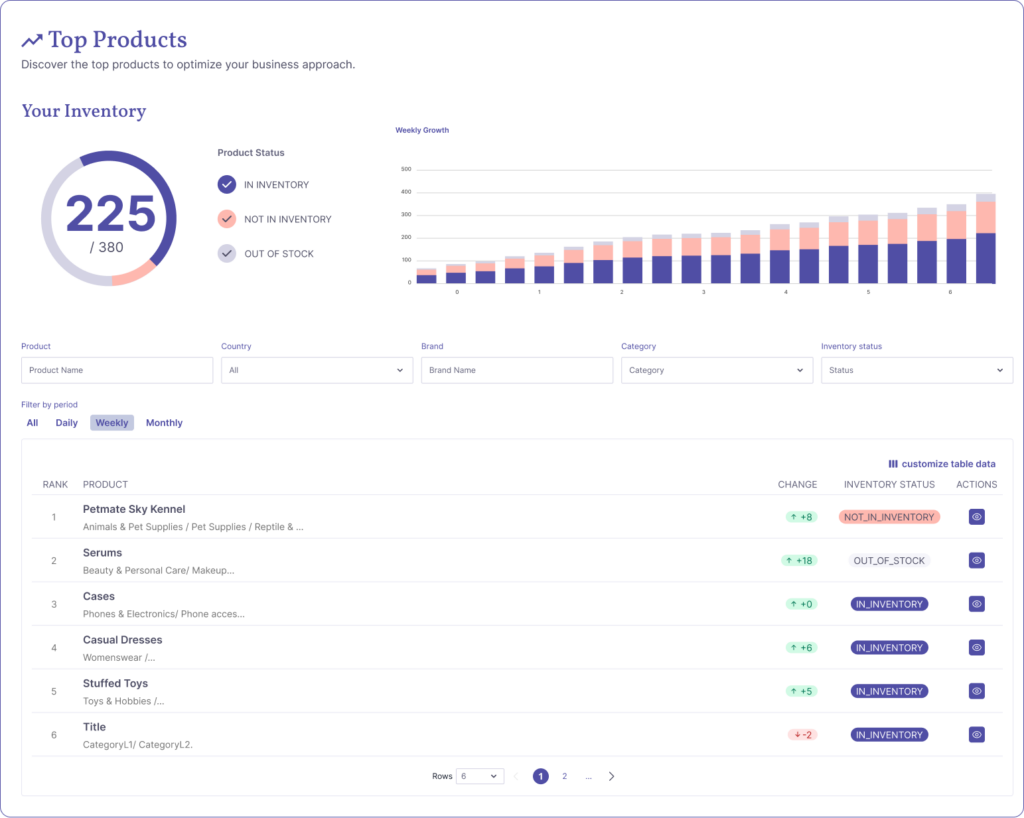
This information not only allows you to adjust your inventory strategy but also helps position your products as the best choice for consumers looking for reliable and quick solutions.
Evaluate and Optimize Your Market Performance
KeyTrends provides you with the data you need to understand how your products are performing in terms of growth and availability. This type of information is essential for adjusting your strategy and maximizing your conversion opportunities.
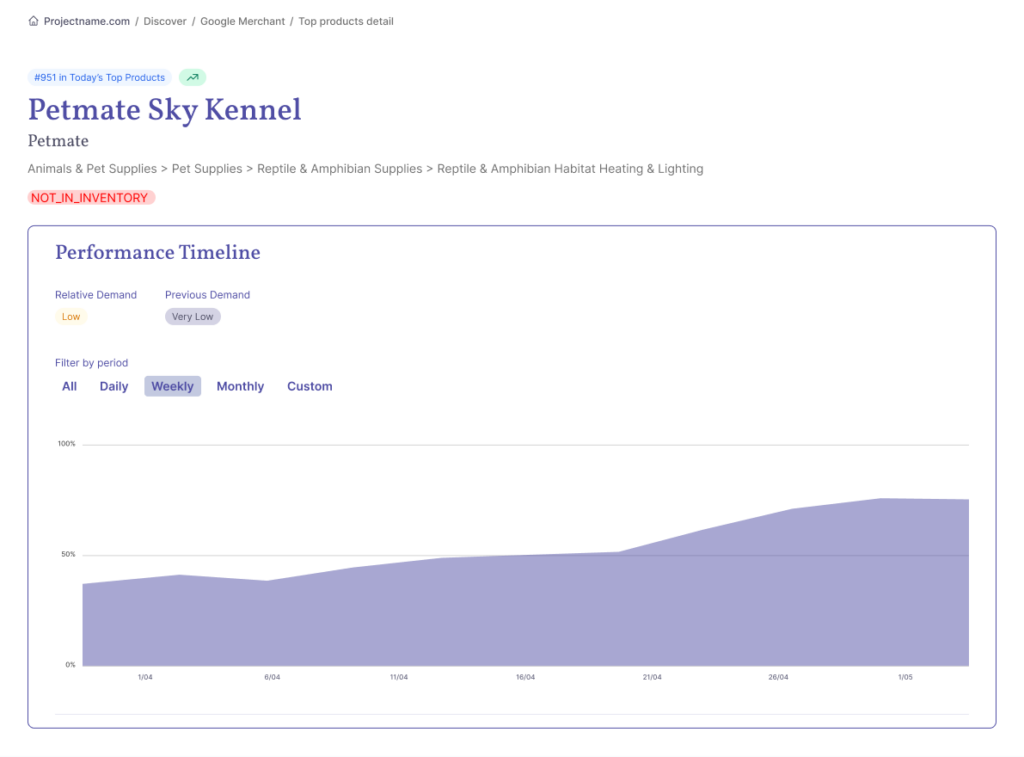
For example, if your prices are more competitive than your competitors, you can highlight this advantage in your advertising campaigns. On the other hand, if your products have higher prices but offer unique benefits, KeyTrends helps you position those values as key differentiators in the market.
Stay Ahead of the Competition and Lead the Market
Using KeyTrends is not just a way to keep up with trends; it’s your tool to stay ahead and set the pace in the market. Identifying opportunities before your competitors, adjusting strategies in real-time, and optimizing campaigns based on solid data are just some of the advantages it offers. This will not only ensure significant growth for your ecommerce but also position you as a leader in your sector, capable of anticipating consumer demands and expectations.
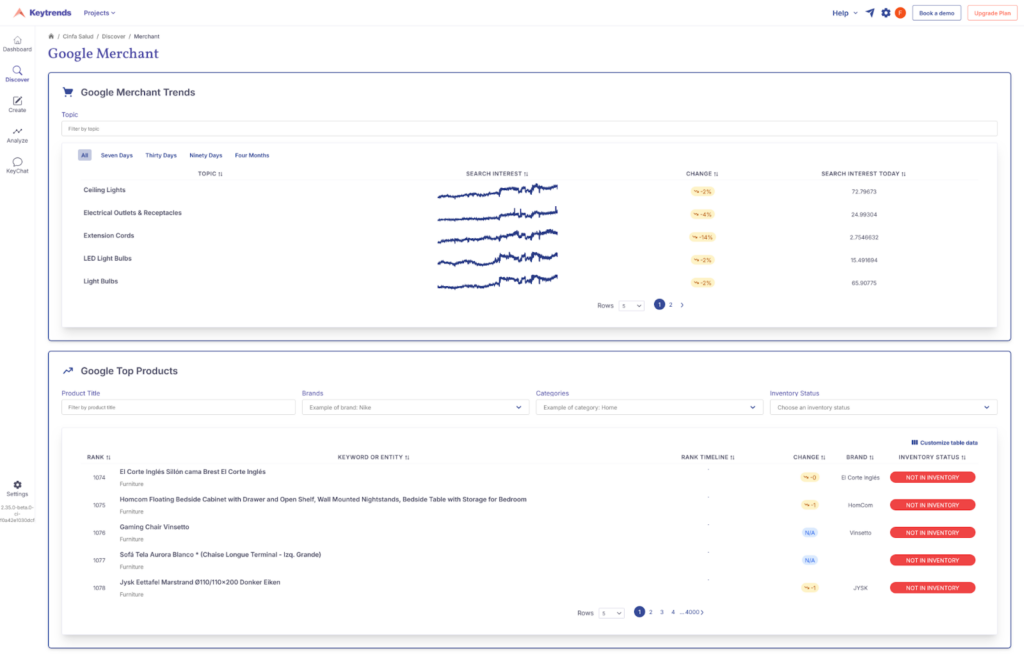
Take Your Strategy to the Next Level with KeyTrends
Don’t let the competition get ahead. With KeyTrends, you have access to everything you need to turn data into strategic actions that transform your ecommerce. From inventory optimization to complete trend insights, this tool becomes the core of your growth strategy.
Use KeyTrends Data to Create a Winning Content Strategy
KeyTrends not only provides you with data to help you stand out on Google Shopping but also serves as the foundation for designing a powerful and effective content strategy. Here’s how you can transform this data into content that attracts, convinces, and retains your customers.
Identify Trends and Create Relevant Content
With KeyTrends reports, you can detect which products or categories are on the rise and use them as the foundation for your content strategy. For example:
- Write guides or tutorials: if a product is gaining popularity, create an article or video explaining how to use it or highlighting its main benefits. This not only helps your customers but also positions you as an expert in the sector.
- Publish product comparisons: if you detect that several items are competing in the same category, create content that compares them and highlights the advantages of your offering.
Instead of just following trends, KeyTrends allows you to anticipate them and generate content at the exact moment users need it.
Create Content Based on Common Market Problems
If your data shows that certain competitor products are out of stock or priced higher, take advantage of this to highlight the availability and value of your own products.
- Create aggressive ads: emphasize in your campaigns that your products are in stock or that you offer faster shipping.
- Publish success stories: share customer stories that show how your products solved their problems. This type of content builds trust and speeds up purchasing decisions.
Boost Your Campaigns
With KeyTrends, you can identify the most searched products in your store and use them to design targeted campaigns. But don’t just showcase the product—aim to drive the customer to the final purchase.
For example, if a customer abandons their cart with a trending product, use personalized content to persuade them. How?
- Emotional email marketing: “Don’t miss out! This product is flying off the shelves, and we know you need it.”
- Social media posts: share content that highlights the value of the product and shows how others are using it to improve their lives.
Boost your SEO with the right Keywords
KeyTrends’ analysis not only tells you which products are popular but also how people are searching for them. Use this information to:
- Optimize your blogs: make sure to include the most relevant keywords in your articles.
- Create specific landing pages: design pages dedicated to trending categories or products to capture qualified traffic.
- Update your existing content: review your older posts and add the keywords that are now trending, ensuring your content remains up-to-date.
With KeyTrends, your content strategy will always be data-driven, not based on assumptions. Don’t wait any longer and take your strategy to the next level with Keytrends.
Frequently Asked Questions about Google Shopping

Here we will address some of the most common questions that ecommerce businesses may have when using Google Shopping.
How much does Google Shopping cost?
Worried about the cost? The return on investment is worth it, but only if you know how to play. Here, we’ll explain how to manage your budget without burning through it.
Google Shopping works through a cost-per-click (CPC) system, where stores pay each time a user clicks on their ad. The cost varies depending on market competition and the type of product.
Ecommerce businesses can adjust their Google Shopping campaign budgets to control costs, using bidding strategies to keep the CPC under control and improve return on investment (ROI).
Can I sell any product on Google Shopping?
Google Shopping has specific policies regarding the products allowed, prohibiting the sale of items such as weapons, counterfeit products, and adult content. It is important for ecommerce businesses to review Google Shopping’s policies and ensure their products comply with the guidelines to avoid account suspension.
What type of images should I use?
Product images should be high-quality, clear, and accurately represent the product. It’s recommended that ecommerce businesses use images with white backgrounds, clearly showing the product while avoiding logos or overlaid text, as Google may reject ads with these elements.

References
- Patel, N. (2022). Google Shopping para principiantes: Una guía completa. neilpatel.com
- DeMers, J. (2023). The Power of Google Shopping for Retailers. Marketing Profs. marketingprofs.com
- Holmes, S. (2022). Cómo Google Shopping impulsa la conversión en ecommerce. Revista Ecommerce Times, 8(2), 45-52.
- Matei, O. (2016, November 17). ¡Nuevo! Los anuncios Showcase de Shopping. VIVA! Conversion. https://vivaconversion.com/blog/publicidad-digital/showcase-shopping-ads
- Clarke, P. (2022). Estrategias de publicidad en Google: Ads y Shopping. Search Engine Journal. searchenginejournal.com
- Fishkin, R. (2022). Cómo usar Google Merchant Center para vender más. SparkToro Blog. sparktoro.com
- Smith, K. (2023). Preguntas frecuentes sobre Google Merchant y Shopping. Digital Marketing Today. digitalmarketingtoday.com
- Elogia. (n.d.). Informes Google Shopping: cómo utilizarlos para analizar precios de mercado y competencia. Recuperado el 15 de noviembre de 2024, de https://blog.elogia.net/informes-google-shopping-como-utilizarlos-para-analizar-precios-de-mercado-y-competencia
